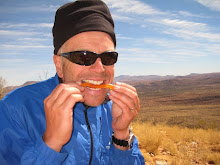I've been playing with the
TrainingPeaks website for a while. I've used it for the last few
months in the build up to the Simpson, so I thought it would be good
to have a look back and see what is there.
The basic premise starts with a concept
called Training Stress Scores. Basically, an hour of completely balls
out, up to the redline, couldn't go any faster, activity nets you a
hundred points. An electronic brain designed by minds immeasurably
superior to our own pro-rates other activities. You can accumulate
points at a rate faster than 100 per hour if you exercise at a
greater intensity. I get 80 points from a workout whose core is 3 x 8
minutes of high intensity effort. You can never break 100 points per
hour, as to do so would break the definition and mean that you need
to recalibrate your base. Over 8 hours, you get a larger training
stress score at a lower rate – 8 hours in the Blueys gives me 388
points.
As a measure of load, not being privy
to the algorithm it seems a fair one. Other measures can be “calories
expended” available from heart rate monitors. TSS is trademarked
(which is a worry*) but is available directly from some Garmin
watches.
TSS is the brown dots – what does it
show? Fortunately this is fairly simple.
I've highlighted our long training runs
in red. The 5 days in the Simpson are highlighted in green.
Look at the long rides. This is the
'Double Double' in the Blue Mountains that Murray and I do once a
month (100km, 2500m ascent). It's around 400 points. Compare that
with the Simpson dots. The message here is that the load is about the
same.
Our long rides are the cornerstone of
our training, the most essential part. They get your body used to
burning fat; when I first rode the DD, I had to eat all the time.
Uncle Tobies, bags of lollies, sandwiches, energy drinks, at the end
of the day I'd still run short. I always order 2 sandwiches because
I'm a greedy bar-steward, but towards the end of this years training
I was bringing one back to the car. On our last run, we skipped the
traditional Lunch Rock at 55km in favour of a romantic lunch at
Bedford Creek, 20km further on.
The second point to make concerns the 5
days of the Simpson alone. Its a downward slope. TSS combines
intensity and duration to measure load. Despite all intentions to
keep it down, the first day was the hardest.The second day, which is
normally the hardest, was actually quite a bit easier. The third day,
which felt like a bastard, was actually the same as the second. The
fourth day, where Murray and I gained 30 minutes on the leader, is
actually easier that any of the previous days. The last day, with
that fantastic ride over Little Red, seems a trivial exercise.
What to say about that? Entering the
Simpson, you can have one of 2 aims; to win or to finish. Finishing
is a laudable aim and by no means easy. If your intention is to
finish the race, this is poor pacing. Pair up with somebody and
cruise - 12.1km/hr is just fine. Take it easy until you're too
tired to hurt yourself. If you intend to win, you probably don't need
to read this.
The lines on the graph show other
features on training peaks. Chronic Training Load, Acute Training
Load and Training Stress Balance (Blue, Pink and Yellow). Let's just
say I'm not sure of the scientific basis behind these – there seem
to be more patents involved than peer reviewed papers. There is
data, certainly, but you can't predict the future by looking at tea
leaves.
CTL is fitness. It's growing as I
training in the months before the race then drops back slightly as
taper.
ATL is fatigue. It drops just before
the race as I taper, then goes crazy ape bonkers.
TSB is the difference of the 2 and
reckoned to be freshness. Again, the taper gives me plenty of
freshness, and the race load takes that away.
Does it mean anything? Maybe.


No comments:
Post a Comment